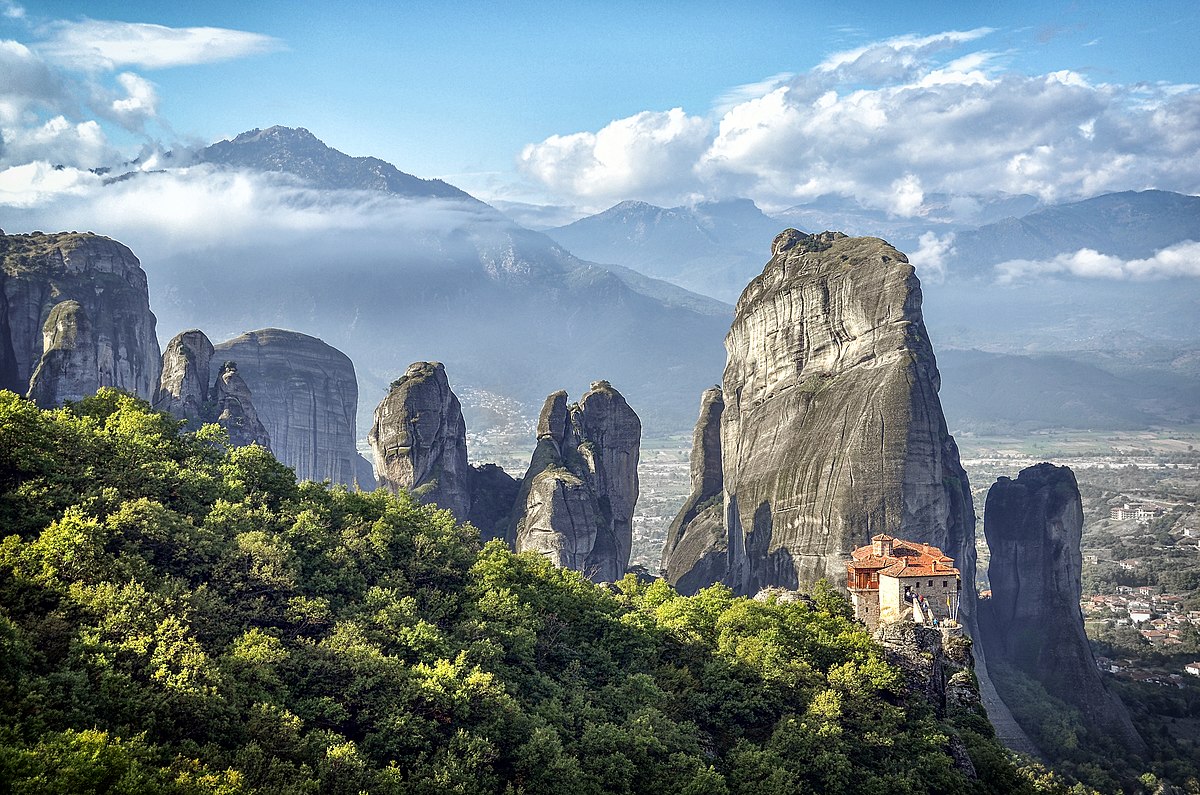Meteora, Greece. Where the earth caresses the sky.

Can a monastery be suspended from heaven? The answer is yes and it is located in Greece, in the region of Thessaly, we speak of the Monasteries of Meteora.

It is about six Orthodox Christian monasteries, World Heritage Site (1988) by UNESCO, built on the summit of rocky masses of sandstone beautifully carved by erosion, at a height of 600 meters and inhabited since the fourteenth century.
The first monks, hermits, reached those peaks (Meteoras, in the Greek language means body fallen from heaven) from their caves driven by an irrepressible desire to be closer to God.
History of the Meteora Monasteries

It is said that Athanasius or rather Saint Athanasius of Meteora, came to this area in the first half of the fourteenth century. He expelled from another monastic region, that of Mount Athos and he founded the Monastery of the Transfiguration (Great Meteor) with a group of faithful.
In the 15th century there was a rebirth of the hermitic ideal of retirement and the search for tranquility and Meteora was the perfect place for it, that is why up to twenty-four monasteries were built in the area, taking advantage of the abundance of cliffs and rocks in the area.

Hence the difficulty of its construction, in fact until the twentieth century when roads and tracks were enabled, the only way to ascend to the monasteries was by chair lifts and ropes with pulleys.
During the Turkish occupation of Greece, it was monasteries that kept Greek culture alive, becoming world-class academic and artistic centers.
At present, 13 are still standing, but only six monasteries are occupied and can be visited, of which only two are female.
Monastery of San Nicolás
Roussanou or Santa Barbara Monastery
Varlaam Monastery
Monastery of the Great Meteor or of the Transfiguration.
Monastery of the Holy Trinity
Monastery of San Esteban
It is estimated that its inhabitants today are about 70 monks (50 nuns and 20 monks). The route to visit them is about 17 KM.
Monastery of San Nicolás (Àgios Nikólaos)
It is the first temple leaving from Kastraki to Meteora and the smallest. Unlike the rest of the monasteries, it rests on a small surface on the top of the rock so it is built vertically: floor on floor up to three and has no cloister.

Going up the steps, you will discover terraced rooms that begin in a hall with the lamps and candles. On the second floor we arrive at the temple (Katholikon), dedicated to Saint Nicholas.
Roussanou or Santa Barbara Monastery
The first monastery for nuns on the route from Kastraki. Its name is attributed to its founder Rousanos, but it is not clear who founded it, it is usually placed around 1388.

The monastery honors Saint Barbara and is dedicated to the Transfiguration.
An old woman from the village of Kastraki continued to preserve the monastery as guardian and in 1988 it has been reborn to worship and is occupied by a female monastic order.
Varlaam Monastery
It is the second of the largest and most important monasteries and is the previous one on the route to the Great Meteor.

It is located 373 meters high from the bottom of the valley and was built in 1541 with an area of about 7,000 square meters.
Access involves following a winding path sculpted in the stone and then climbing a long steep staircase.
Monastery of the Great Meteor (Transfiguration)
Welcome to the largest and most important monastery in Meteora. The Monastery of the Transfiguration is located 613 meters high, in the highest part of the complex.

The church was dedicated to the Virgin Mary and later a new temple dedicated to the Transfiguration of Jesus was built.
Monastery of the Holy Trinity (Agía Triada)
This monastery (15th century) is one of the most difficult to reach, you just have to see the image to understand it.

This monastery was ascended by means of mobile or network ladders until in 1925 140 steps were carved into the rock.
This monastery contained many relics that were looted by the Nazis, including manuscripts and precious stones from donations.
The icons and manuscripts that belonged to the monastery and that were rescued are now in the Monastery of San Esteban.
Monastery of San Esteban (Àgios Stéfanos)
The Monastery of San Esteban, the second inhabited by nuns, is the one with the easiest access since there are no stairs, and you only have to cross an 8 meter long bridge.

Inside there are two churches, one from the 16th century, the Chapel of San Esteban and another from the 18th century dedicated to San Charalambos.